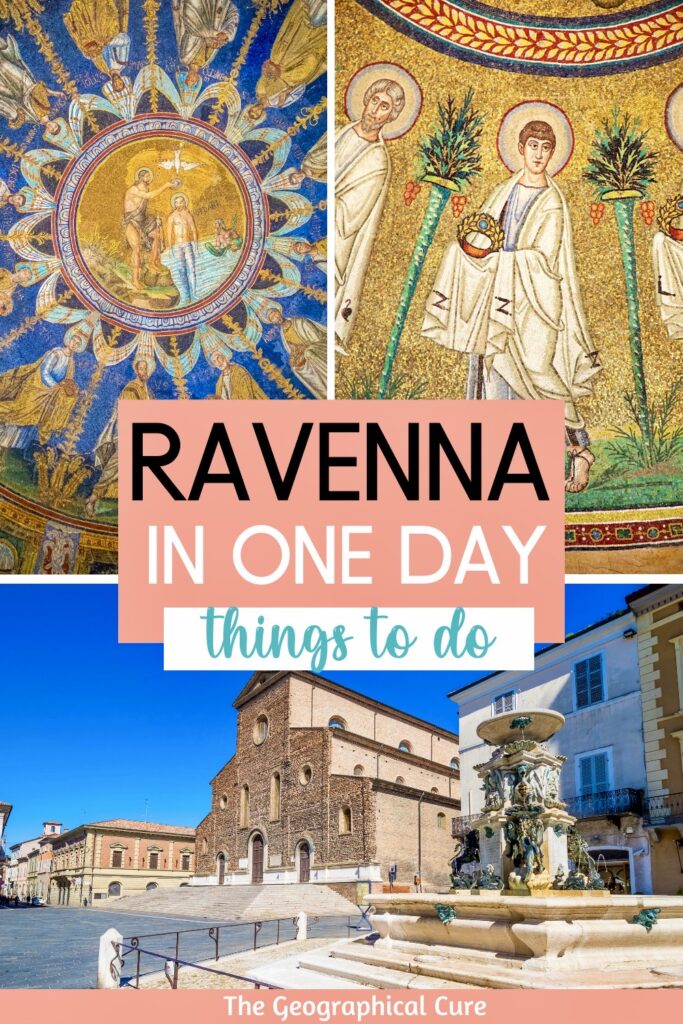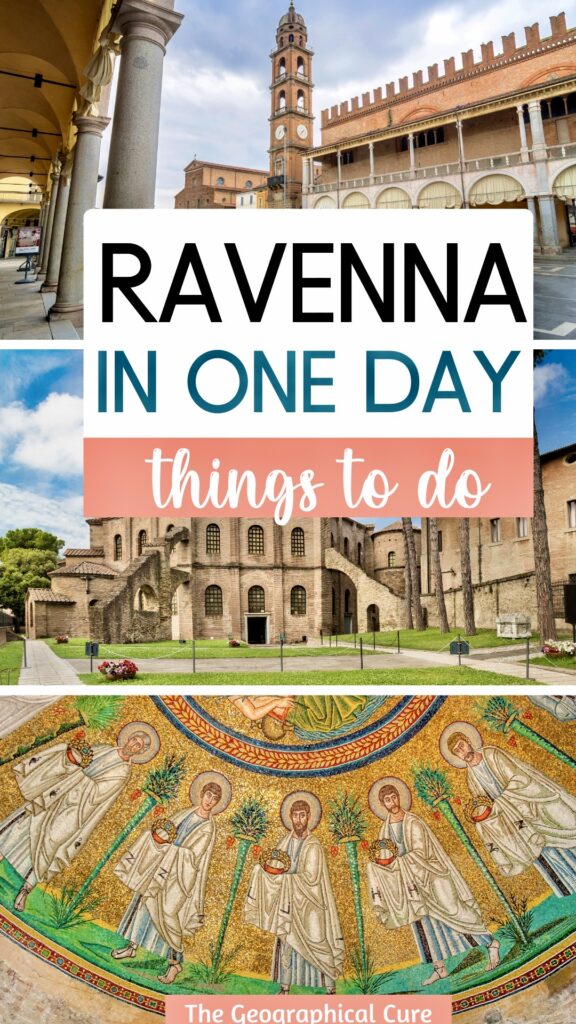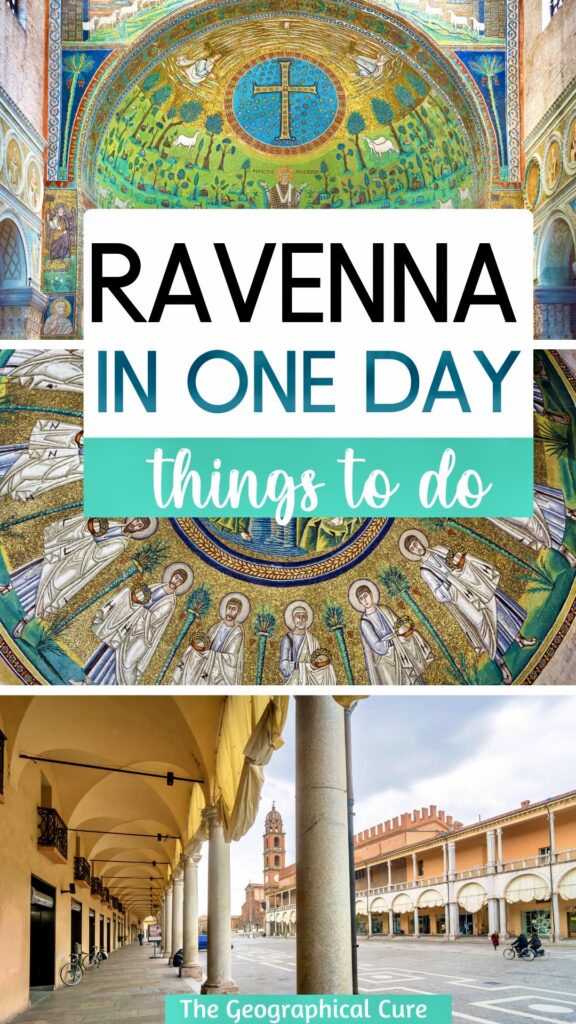Nestled in Italy’s Emilia-Romagna region, Ravenna is a hidden gem that packs a big punch when it comes to history, art, and culture. To help you have the best visit, I’m handing over my one day in Ravenna itinerary.
Ravenna served as the capital of the Western Roman Empire during the 5th century and later became a key center of the Byzantine Empire. As a result, the city is filled with a plethora of stunning monuments and architectural wonders that have been preserved for centuries.
Ravenna’s main claim to fame is its collection of early Christian and Byzantine mosaics, which are recognized UNESCO World Heritage sites. Ravenna’s sparkling mosaics are renowned for their vibrancy, detail, and unique style.
What makes Ravenna’s mosaics truly special is that they showcase the transition from the Roman world to the early Byzantine world. With the decline of the Greco-Roman world, Byzantine art moved away from classical ideals and naturalism.
Instead, Byzantine artists embraced a flatter and more abstract style. They sought to depict an intangible and ethereal world, rather than faithfully reproducing reality. As a result, the mosaics are a stunning representation of the glory and mystery of Byzantine culture.
However, there is much more to Ravenna than just its mosaics. The city is a treasure trove of history, culture, and gastronomy waiting to be explored.
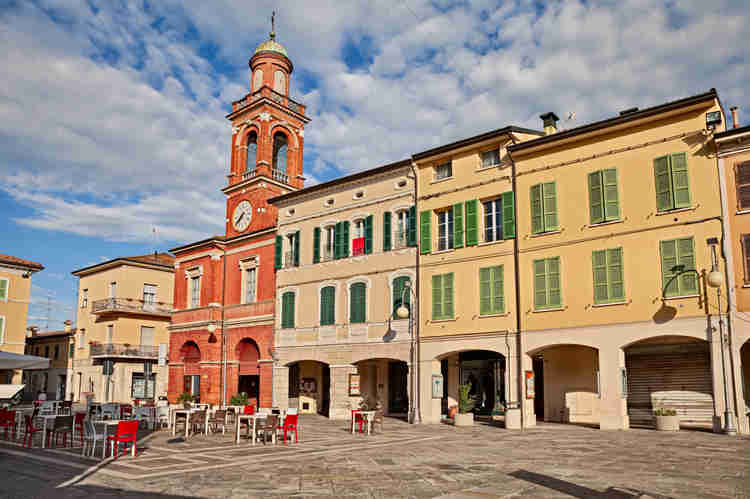
Overview Of One Day In Ravenna Itinerary
Here’s a quick snapshot of what you can see with one day in Ravenna:
- Mausoleum of Galla Placidia
- Basilica of San Vitale
- Baptistery of Neon
- Basilica of Sant’Appollinaire Nuovo
- Araian Baptistery
- Basilica San Francesco
- Dante’s Tomb
- Chapel of Sant’Andrea
- Choice of museums
You may be interested in these guided tours. Be sure to book ahead in high season.
- guided mosaic tour
- private mosaic tour
- Ravenna walking tour
- Ravenna walking and street food tour
- Ravenna day trip from Bologna
- guided Dante tour
Single admission tickets for the UNESCO sites aren’t available. You’ll need to purchase a combination ticket for 10.50 or 12.50 euros.
One Day In Ravenna Itinerary
Here’s my recommended itinerary for seeing Ravenna’s sites in the most efficient way. You can add or delete things to fit your pace of travel.
You could also easily spread these sites and museums out over 2 days. To visit the churches, you’ll need to have your shoulders and knees covered.
Mausoleum of Galla Placidia
Start your one day in Ravenna with the Mausoleum of Galla Placidia.
This small structure was originally meant to be the final resting place of an empress and is now the Mausoleum of Galla Placidia. She was an influential woman — a wife, daughter, and granddaughter of Roman emperors.
Despite the austere exterior, the interior of the mausoleum is breathtaking, featuring Ravenna’s oldest and perhaps best mosaics. UNESCO describes the site as “the earliest and best-preserved of all mosaic monuments, and at the same time one of the most artistically perfect.”
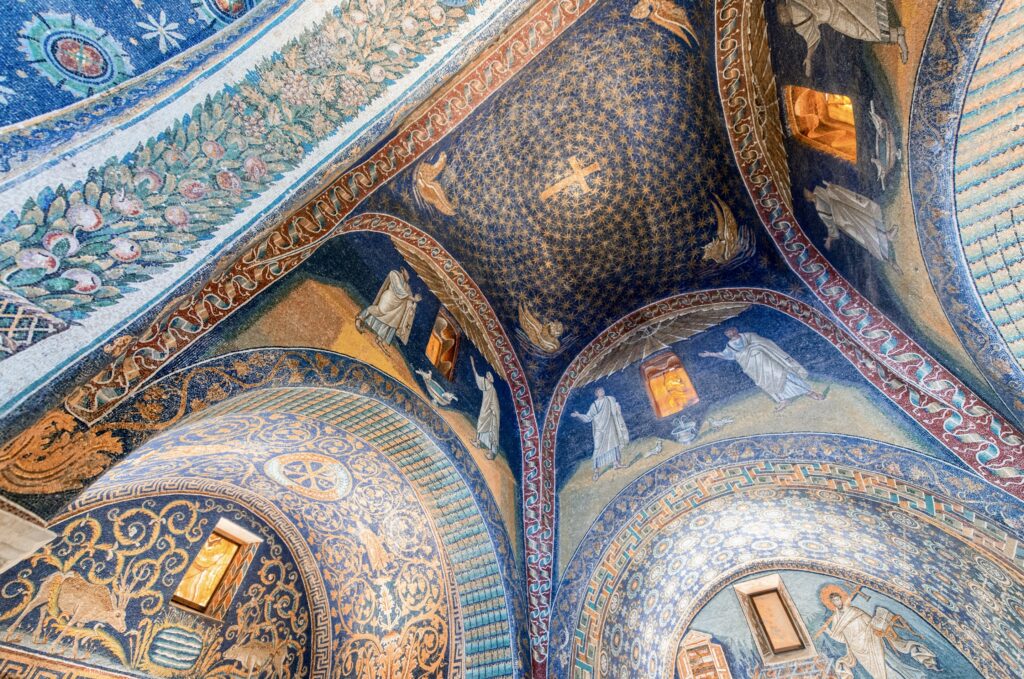
The stunning night sky is a masterpiece, with vivid peacock blue mosaics adorned with white and golden stars. A golden cross at the center of the dome symbolizes the triumph of the cross over death, while the symbols of the four evangelists surround it.
Two additional mosaics are worth examining closely.
The northern lunette above the entrance features a beardless Christ depicted as the Good Shepherd, evoking a distinctly Roman aesthetic. The southern lunette depicts the martyrdom of Saint Lawrence.
Basilica of San Vitale
Next, visit the nearby Basilica di San Vitale, which is a short walk from the Mausoleum. It’s the most visited site and the crown jewel of Ravenna.
It’s most famous for its dazzling Byzantine mosaics in the presbytery and choir, which aim to evoke a heavenly realm.
One of the most impressive mosaics is located in the apse above the altar. It depicts Christ the Redeemer sitting on an orb that represents the universe.
On either side of him are angels, and below him flow the four rivers of paradise. San Vitale is depicted receiving a crown from Jesus, while a bishop holds a model of the church.
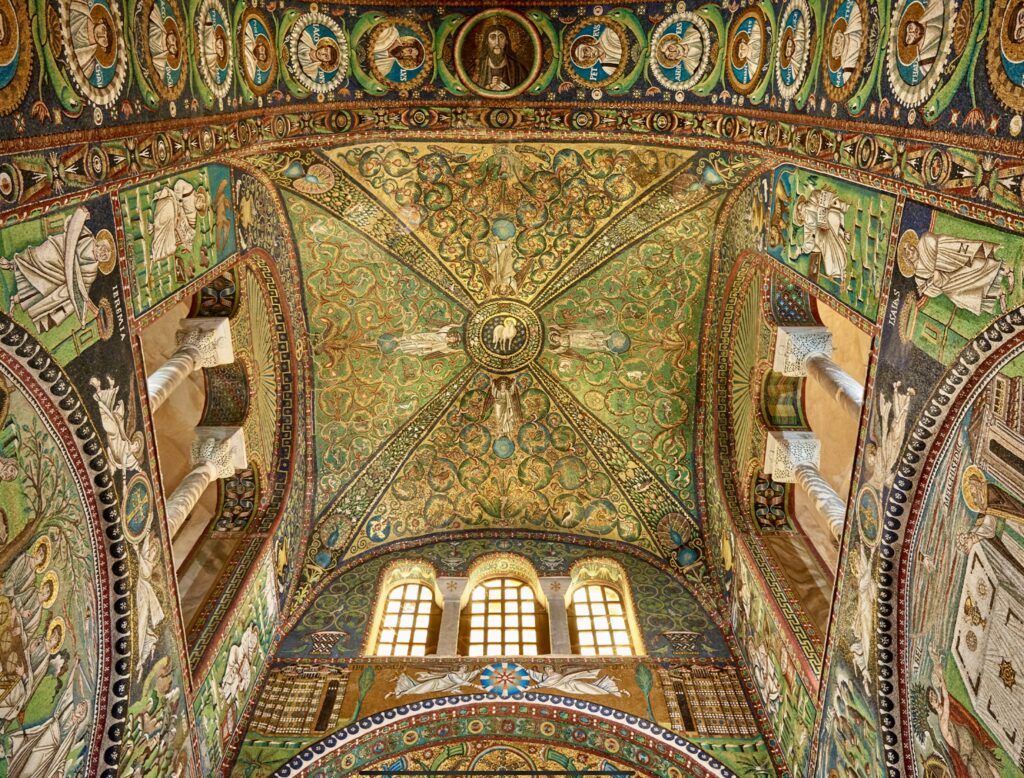
The most famous panels in the basilica are dedicated to the Emperor Justinian and his wife Theodora. They show the pair making offerings to Jesus against a field of gold, with both resplendent in fine capes and jewels.
These mosaics are a piece of political propaganda, as they depict the pair as divine figures, conflating the emperor with Christ and Theodora with mother Mary. The message is clear: the peace and prosperity of the Byzantine Empire is brought to you by both the emperor and God.
The other San Vitale mosaics illustrate scenes from the Old Testament, depicting images of the 12 apostles and 4 evangelists, with the Lamb of God overseeing everything from atop the vaulted ceiling.
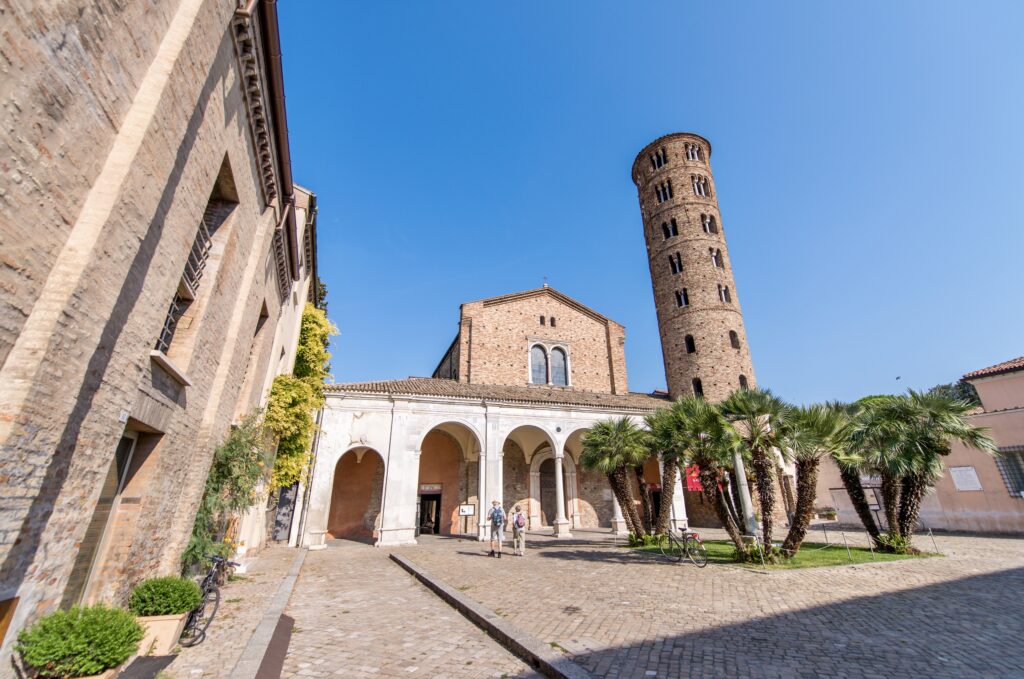
Basilica of Sant’Apollinare Nuovo
Next, head to the Basilica di Sant’Apollinare Nuovo, which is located about 10 minutes away by foot.
The church was originally built by Theodoric the Great in the early 6th century as an Arian place of worship. The Arian cult was the official religion of the court of Emperor Theodoric.
They followed the doctrine of an Egyptian priest named Arius. Unlike early Christians, the Arians believed that Jesus was created by God and therefore subordinate in the holy trinity.
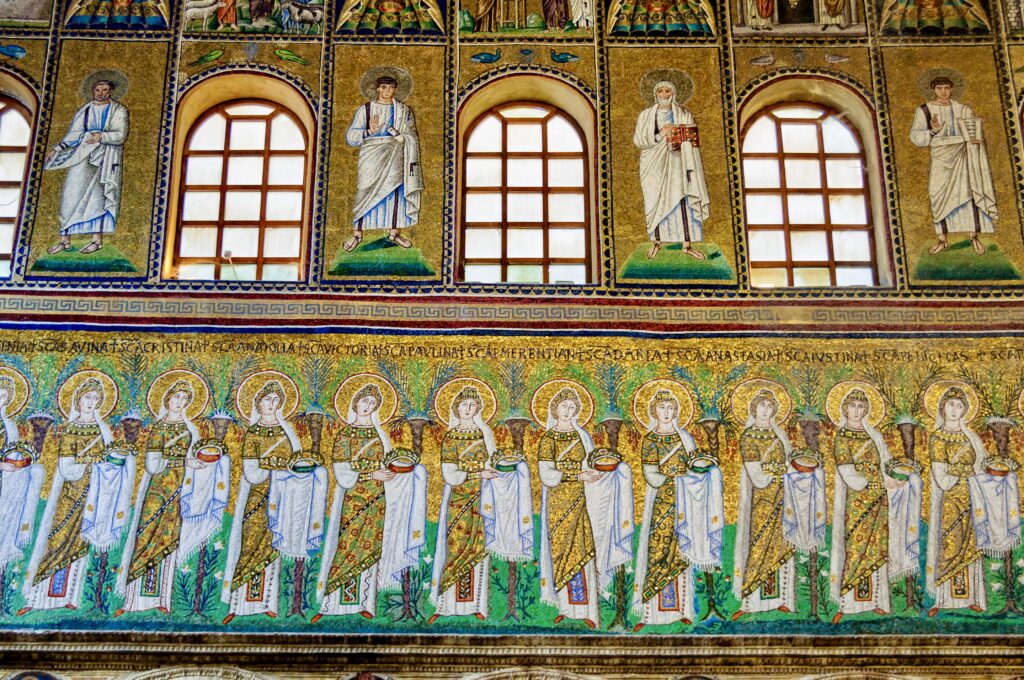
After Justinian conquered Ravenna, the basilica was converted into a Catholic church and re-dedicated to Saint Martin of Tours. He was known for defending Christian doctrine against heretics.
In the 9th century, the church was renamed Sant’Apollinare Nuovo when the body of Saint Apollinare, the first bishop of Ravenna, was relocated there.
So, the church has an interesting history of religious changes and power struggles. It’s worth a visit to see the stunning mosaics and architecture that reflect the influence of both the Arian and Catholic faiths.
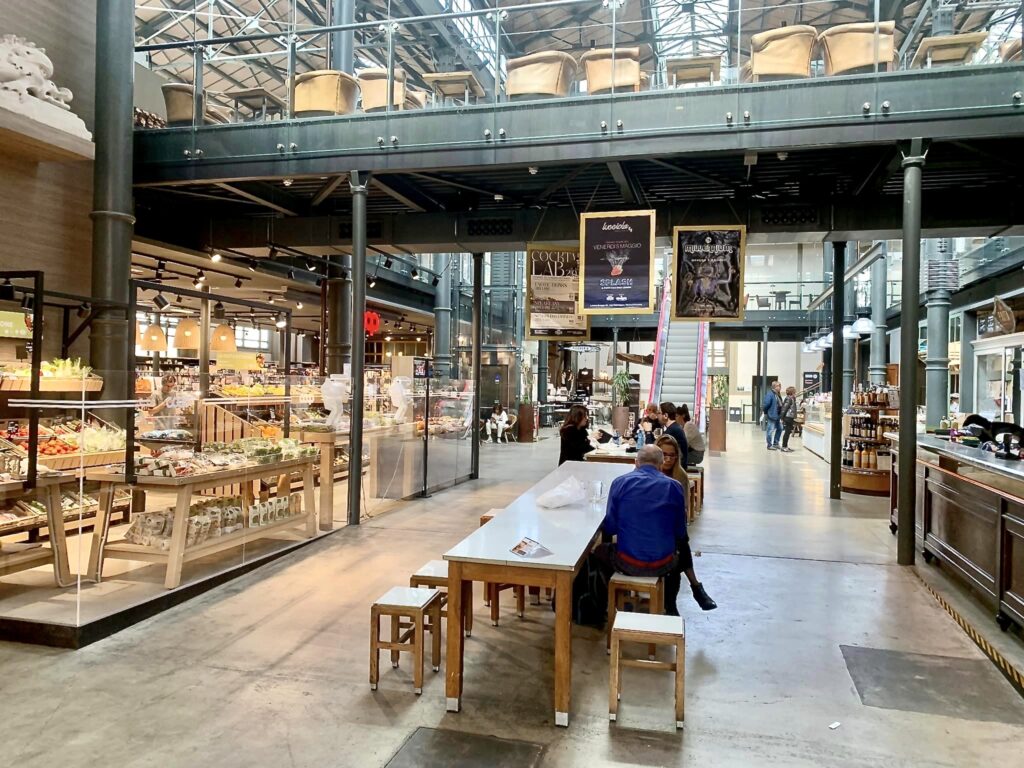
Lunch Break
For lunch, head to Ravenna’s food market, the Mercato Coperto di Ravenna.
The market offers a wide variety of local produce, meat, fish, cheese, and other specialty foods. It’s a great place to explore and try some of the delicious food that Ravenna has to offer.
The market also has several small eateries and food stalls where you can enjoy a quick snack or a full meal. These food spots offer a range of traditional dishes, including piadina (a local flatbread), pasta dishes, and seafood specialties.
Neonian Baptistery
After lunch, visit the Baptistery of Neon. It’s an extraordinary monument that dates back to 400 A.D., making it Ravenna’s oldest structure. It’s a true testament to the artistry and skill of the time and remains one of the most well-preserved baptisteries in the world.
Unlike Ravenna’s other mosaics, the baptistery features a blend of Greco-Roman and Byzantine styles. The vibrant blue, green, and gold mosaics that adorn the entire ceiling are simply breathtaking.
The images themselves are highly symbolic. They portray John the Baptist baptizing Christ in the River Jordan, a testament to the building’s intended purpose.
Furthermore, an outer ring of mosaics depicts stunning architectural scenes, which are characteristic of Roman mosaics. The combination of these elements creates an atmosphere of awe and wonder that is truly unforgettable.
Arian Baptistery
After visiting the Baptistery of Neon, take a short stroll to the nearby Arian Baptistery. It was constructed by the Ostrogoth king, Theodoric the Great, towards the end of the 5th century.
The reason for its construction was primarily political. It aimed to maintain peace between two powerful groups in the empire: the Goths (who were Arians) and the Latins (who were Christians).
At the time, only the Christians had their own baptistery. So Theodoric built the Arian Baptistery as a separate facility to prevent any religious conflicts.
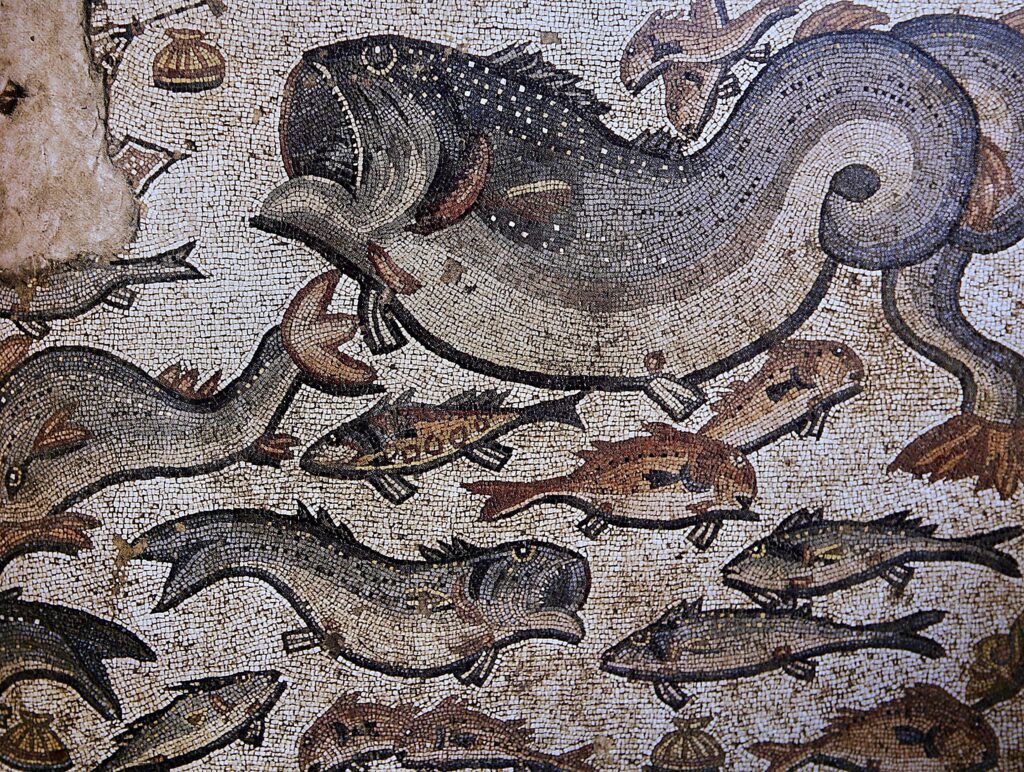
The Arian Baptistery is a small, octagonal building. Though the previous stucco and decorations have disappeared, the mosaics in the cupola are still stunning.
This baptistery is a rare instance of art from a lost religion. The concentric mosaics depict the procession of the 12 apostles and the baptism of Jesus.
The mosaics present an androgynous Jesus, who is portrayed as both human and divine. Above his head, a dove is shown, which is the symbol of the Holy Spirit.
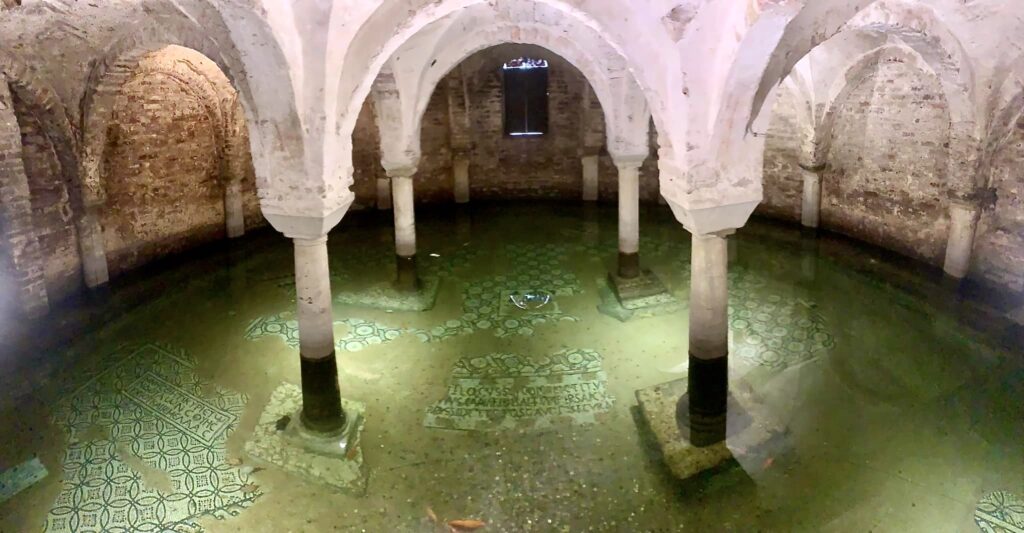
Basilica of San Francesco
The Church of San Francesco in Ravenna was built in the 5th century as a small chapel, but it was later expanded and modified over the centuries. Today, the church has a mix of architectural styles, including Romanesque and Gothic elements.
The church interior is fairly simple. It’s famous as the location of Dante Alighieri’s funeral.
The most remarkable feature of the church is its blue-green water chambers in the basement crypt, which you can only visit on a guided tour. They were once part of the ancient system of Roman cisterns and have remnants of Roman mosaics.
You access the underground chambers via a staircase leading down from the church. The chambers are made of brick and stone and are supported by arches. The atmosphere is cool and damp, with a faint smell of moss and algae.
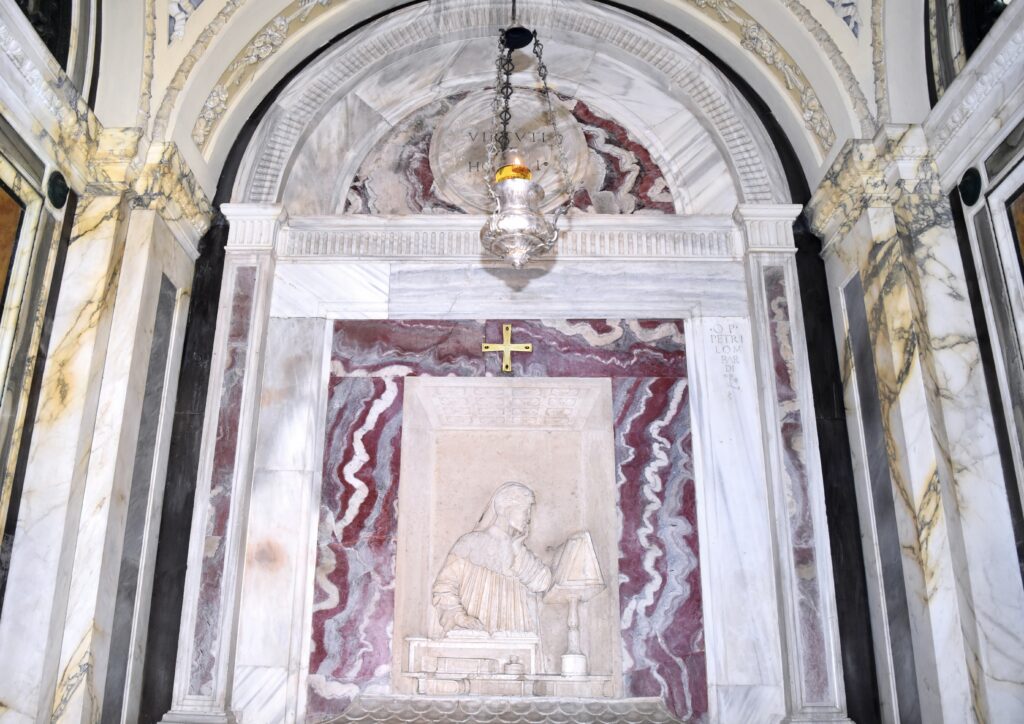
Bonus: Dante’s Tomb
Dante’s tomb is a simple white marble structure located in the Quadrarco di Bracciofore. It’s an oratory adjacent to the Basilica of San Francesco. The tomb was created in 1780 by the Venetian sculptor Camillo Morigia.
It features a relief of Dante’s face, as well as an inscription in Latin that reads “Dante Alighieri, a Tuscan poet, who deserved to be called a light of Italy, is buried here.”
In the courtyard, you can also see the Bells of Dante. It’s a hand made moving bronze gate with bells decorated with the coats of arms of Ravenna, Rome, and Florence. The bells are still rung on special occasions and you can move them by pulling on the ropes attached to them.
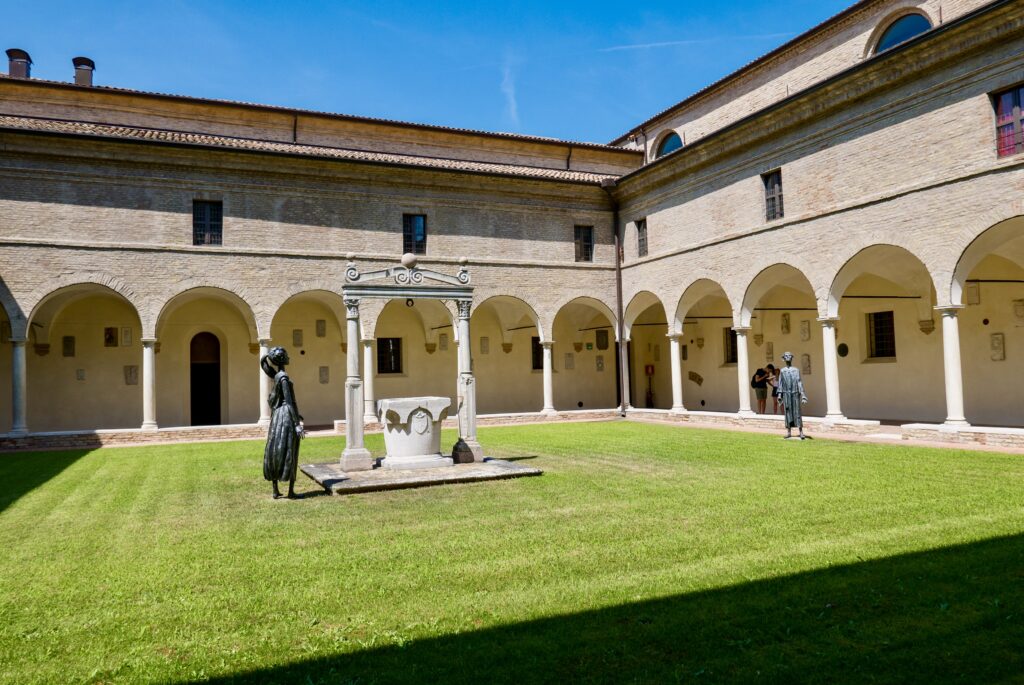
Choice of Museums
Last but not least, if you have any time left on your one day in Ravenna itinerary, hit one of Ravenna’s museums. You have several choices.
The Dante Museum is dedicated to the life and work of the famous Italian poet Dante Alighieri. He spent the last years of his life in Ravenna and is buried there. The museum is located in the former Franciscan convent of San Francesco, which is where Dante stayed during his time in Ravenna.
It features a pretty decent collection of artifacts related to Dante’s life and work, including manuscripts, early editions of the Divine Comedy, and artwork inspired by his writings.
The Archiepiscopal Museum in Ravenna is located adjacent to the Chapel of Sant’Andrea. (In the tiny chapel, you’ll find a rare mosaic depicting Jesus as a victorious warrior.)
The museum is housed in the former residence of the archbishop and contains a vast collection of early Christian and Byzantine art and artifacts. The museum’s exhibits include mosaics, paintings, sculptures, and religious objects from the 4th to the 17th century.
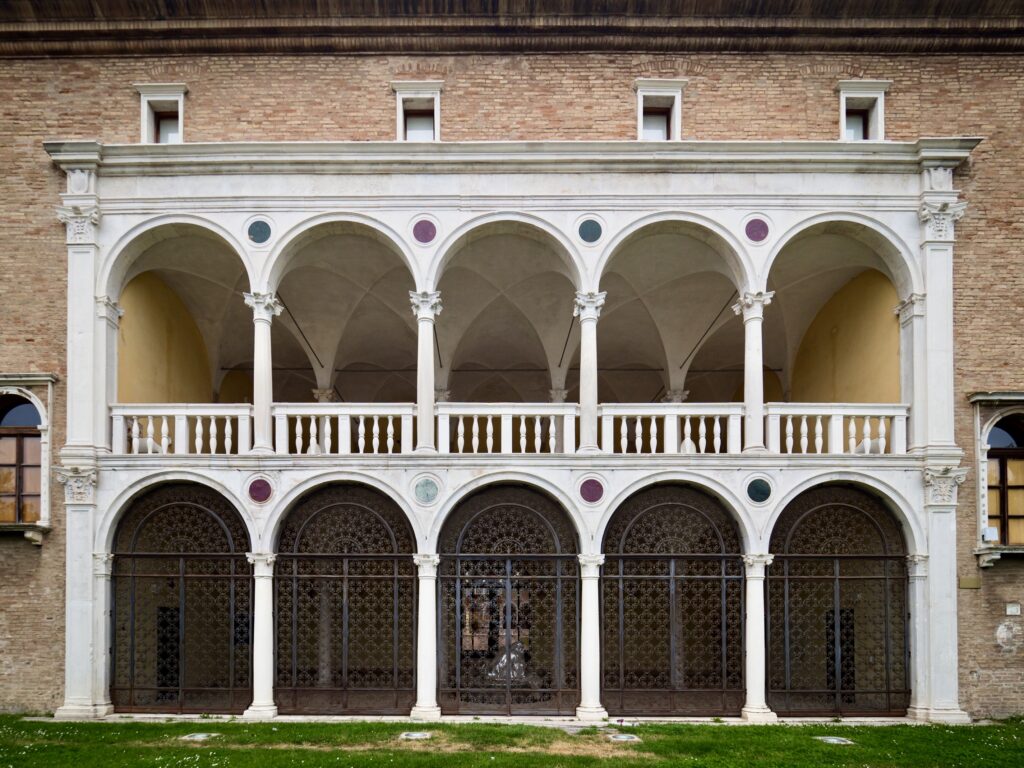
Some of the highlights of the museum’s collection include the ivory throne of Bishop Maximian, a 6th century silver plate depicting the martyrdom of St. Vitalis, and a collection of ancient Roman and medieval coins.
If you’re a fan of contemporary art, head to the MAR museum. It features a diverse collection of contemporary art, including paintings, sculptures, and installations by Italian and international artists.
In addition to its permanent collection, the MAR museum hosts temporary exhibitions throughout the year that showcase the work of contemporary artists from around the world.
National Museum of Ravenna, the Museo Nazionale di Ravenna, houses a vast collection of artifacts and archaeological finds from Ravenna.
The collection includes sculptures, mosaics, and other works of art from the Roman, Medieval, and Renaissance periods. Among the most famous pieces are the mosaics from the Basilica of San Vitale and the Mausoleum of Galla Placidia.
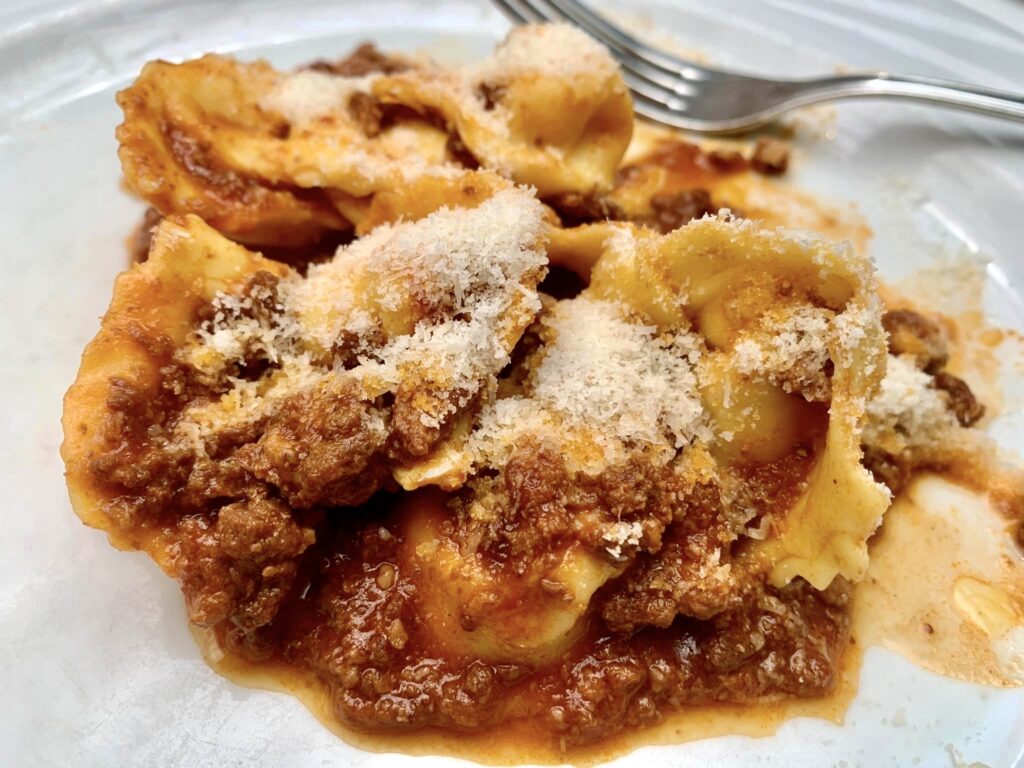
Evening
In the evening, head to the lively Piazza de Popolo. Polish off your sightseeing with a climb up the Torre Civica, Ravenna’s very own leaning tower. The tower has a total of 162 steps, and the climb takes about 15-20 minutes.
Once you reach the top, you’ll be rewarded with panoramic views of Ravenna and its surrounding area, including the nearby Basilica di San Vitale and other historic landmarks.
Then, have an apertivo and dinner at a traditional restaurant.
Ca de Ven is located in the historic city center, near the Piazza del Popolo. The restaurants has frescoed vaulted ceilings and is known for its traditional Romagnolo cuisine. La Gardela is another good option with a sweet location under the arches of the city’s Torre Civica.
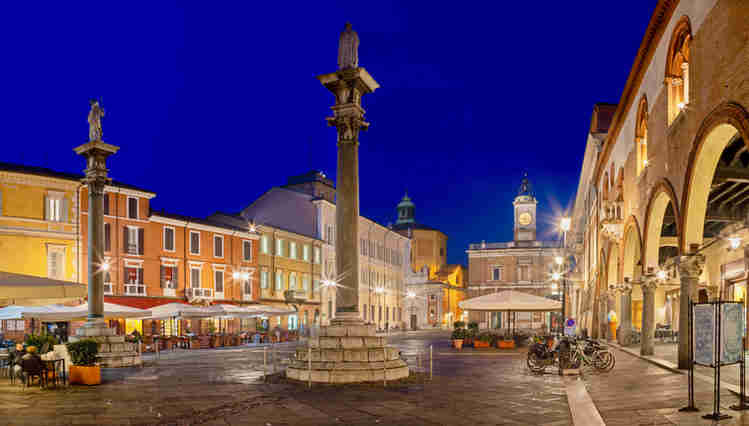
Tips For A One Day in Ravenna Itinerary
Here are some must know tips for spending one day in Ravenna.
1. How To Get To Ravenna
Getting to Ravenna is easy by plane, train, or car.
The closest airports are Bologna (1 hour away) and Venice (2 hours away). You can book a private transfer from the Bologna Airport.
If you prefer train travel, take a regional train from Bologna, with hourly departures and a travel time of around 1 to 1.15 hours. The train station is located within walking distance of the town center. Once you arrive, simply walk down Via Farini to start exploring the city.
Ravenna is also a perfect destination for a day trip. There are hourly direct trains departing from major cities like Venice, Florence, Bologna, and Ferrara. You can also stop in Ravenna on your way from Venice or Padua to Florence.
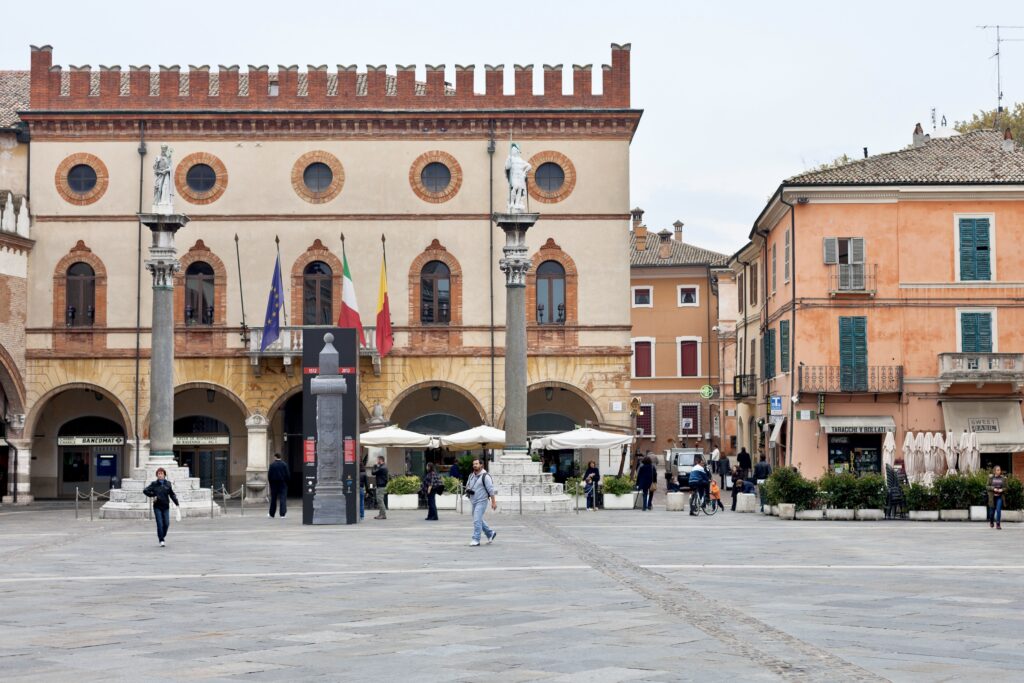
For those traveling by car, the A14 motorway is the closest to Ravenna. It takes around an hour to drive from Bologna to Ravenna.
There are several parking lots to stash your car. Piazza Baracca Parking is in the city center near the Piazza del Popolo. Piazza Kennedy Parking is near the train center. Piazza Aldo Moro Parking is near the Basilica of San Vitale.
2. How To Get Around Ravenna
Ravenna is a relatively small city, mostly pedestrianized, and entirely walkable. If you prefer to bike, Ravenna has a network of bike paths that make it easy to explore on two wheels. You can also take taxis or buses.
3. How To Get Mosaic Tickets
You can see 4 of the best Ravenna mosaics listed above with a combined ticket. You can purchase it online here for 10.50 euros. It’s valid for a single entry per site over 7 days.
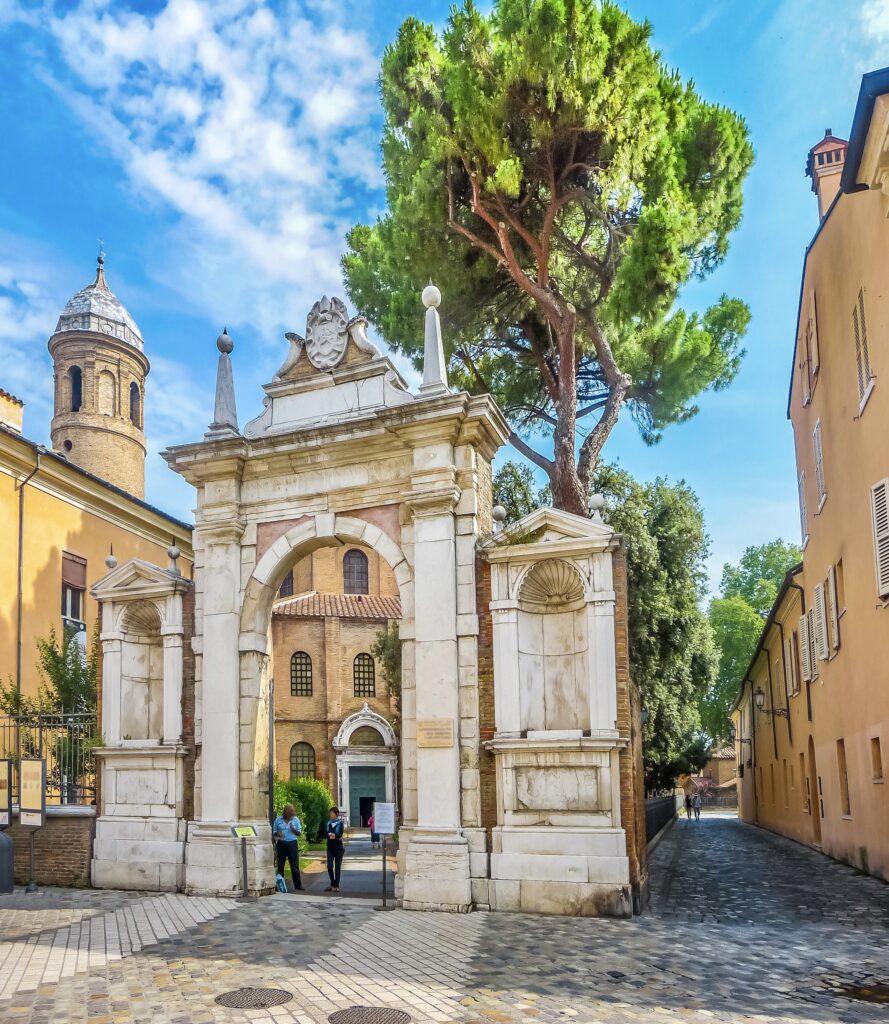
Purchasing the combination ticket is the ONLY way to see these sites. There is an addition 2 euro surcharge to see the Mausoleum of Galla Placidia and the Neonian Baptistery.
If you purchase your ticket online, you can print it or save it to your device. You’ll have to scan the ticket to enter each site.
4. Where To Stay In Ravenna
You have a few good hotel options in Ravenna. Check out:
- Hotel Palazzo Bezzi (luxury hotel with wellness center and Turkish bath
- Club de Luxe B&B (cozy bed and breakfast centrally located)
- Exclusive Aparthotel la Reunion (charming and hip suites)
- Grand Hotel Mattei (spacious rooms and well center 5 minutes from Ravenna)
5. Is Ravenna Worth Visiting?
Ravenna is on the tourist map for one reason: its ancient mosaics. Thus, it will appeal most to those who love art and architecture or are on the UNESCO trail in Europe.
That said, it’s a historic place with a lively town center and delicious cuisine. And it’s more laid back than other more touristy towns in the region.
6. When Is The Best Time To Visit Ravenna?
I would avoid summer. That is peak tourist season and the summers are hot and humid. Conversely, winter is cold and rainy, so I would avoid visiting Ravenna then as well.
Spring and fall are the best times to visit. If you like music, the Ravenna Festival takes place from May to July. Founded in 1990, it’s one of the most prestigious musical festivals in Italy.
7. Is One Day In Ravenna Enough?
You can see some, but not all, of the sites in Ravenna in one day. Each of the mosaic sites has its own unique history and it can take a time to explore and appreciate them fully. But if you arrive at opening time (9:00 am) and stay until closing time (6:00 pm), you will see the major attractions.
If you only have one day to explore Ravenna, it is best to prioritize which sites are must sees and pre-book a ticket to avoid long queues and save time. If you want to see more of Ravenna’s museums or the sites in nearby Classe, you may want to allocate 2 days to Ravenna.
8. More Than One Day in Ravenna?
If you have more than a day in Ravenna, there are plenty of other things to do near Ravenna.
Sant’Apollinare in Classe is another UNESCO World Heritage Site. It’s located in the suburb of Classe, 3 miles outside the historic center of Ravenna. The basilica was built in the 6th century and features stunning Byzantine mosaics that cover the walls of the nave and apse.
The mosaics depict scenes from the life of Jesus, as well as figures from the Old and New Testaments. The style of the mosaics is similar to those found in the other Byzantine-era monuments in Ravenna. But the use of vibrant colors and intricate details in the figures and backgrounds make them particularly impressive.
You can get there by bus, taxi, or car from the city center of Ravenna.
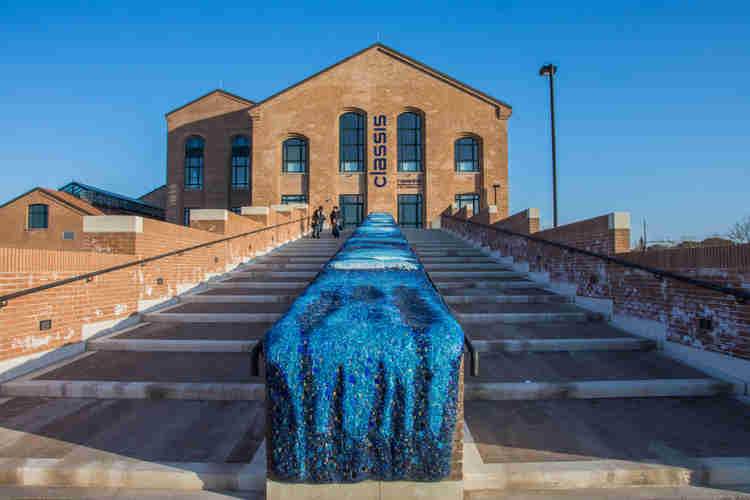
If you’re interested in exploring Ravenna’s rich history further, don’t miss the Classis Museum. Housed in a former sugar factory, the museum features striking architecture and an impressive collection of over 600 exhibits.
As you approach, you’ll be greeted by a breathtaking blue mosaic on the staircase, reminiscent of a wave. This sets the tone for the museum’s magnificent displays.
Arranged chronologically, the exhibits offer a comprehensive journey through Ravenna’s history, spanning from its origins to the year 1000. Among the treasures on display are Roman mosaics, which are brought to life through 3D reconstructions, scale models, and films.
If you’re keen to explore further afield, the UNESCO city of Vicenza is just a short 18 mile trip from Ravenna. Famous for its Palladian architecture, including the stunning Villa Rotonda, it’s a feast for the eyes.
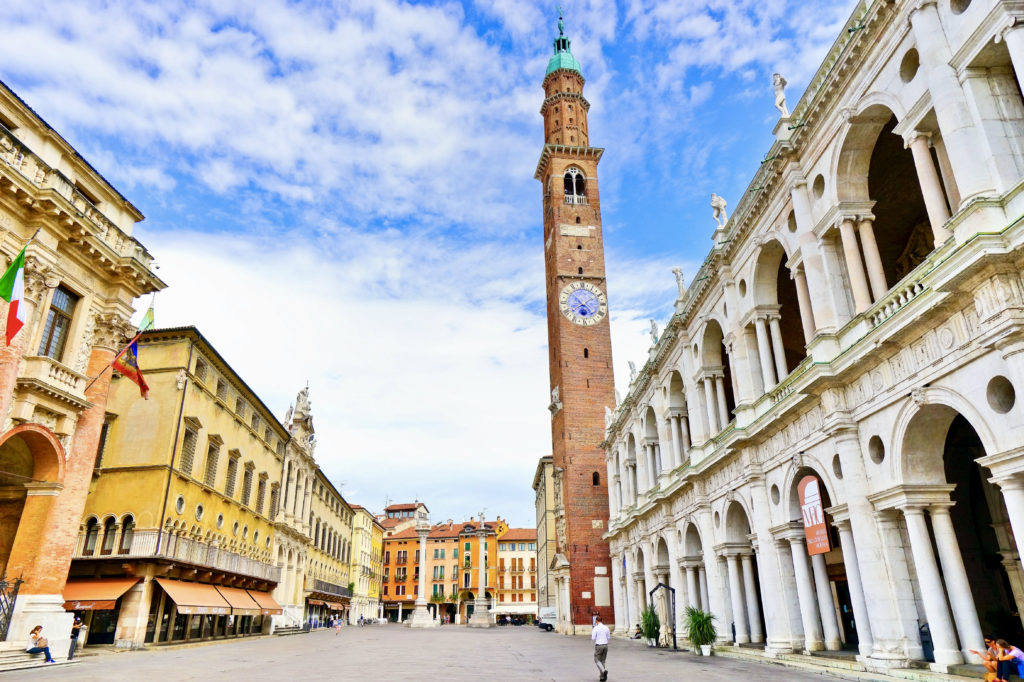
Another UNESCO World Heritage Site worth exploring is Ferrara, where you’ll discover a well-preserved medieval center, impressive Renaissance architecture, and a beautiful castle.
I hope you’ve enjoyed my one day in Ravenna itinerary. You may enjoy these other Italy travel guides:
- 3 day itinerary for Rome
- 5 day itinerary for Rome
- 1 day itinerary for Vatican City
- 3 day itinerary for Florence
- 2 day itinerary for Venice
- 1 day itinerary for Milan
- 1 day itinerary for Siena
- One week in Umbria
- 10 days in Italy itinerary
- 10 day itinerary for Tuscany
- 12 ways to spend 1 week in Italy
- 2 weeks in Sicily itinerary
If you want to visit Ravenna, pin it for later.

